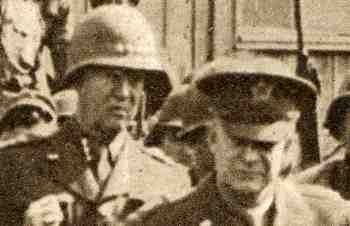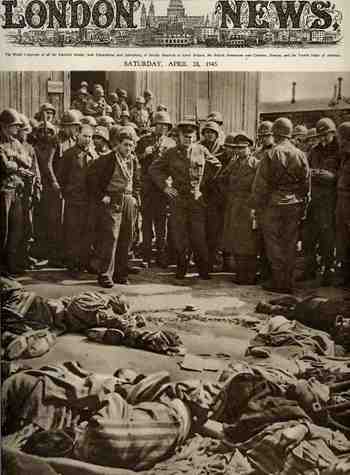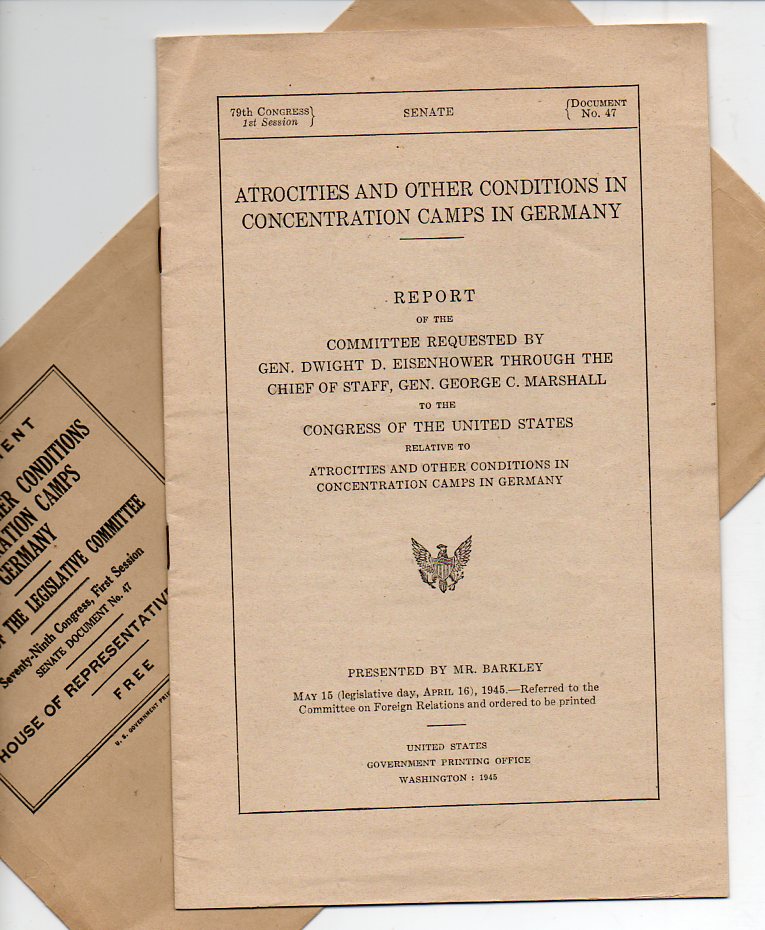ITEM: Report of the Committee requested by Gen. Dwight D. Eisenhower through the Chief of Staff Gen. George C. Marshall to the Congress of the United States relative to atrocities and other conditions in concentration camps in Germany. (Alban W. Barkley.)8x5 inches, 15pp. With the original Congressioonal mailing envelope. Rare i the original format. $500
Ref: JF Ptak Science Books Post 1259 (Continuing Post 273)
[On General Eisenhower in the Ohrduf concentration camp, April 1945, and the report that came from that visit, Atrocities and Other Conditions in Concentration Camps in Germany..May 1945.]
 This picture Generals Eisenhower and Patton pretty much says it all--I'm not a scholar or expert on these two men, but I cannot recall seeing any photos of them with a look of utter seething repulsion. (Eisenhower would say that it was important for him to bear witness himself to all of the horrors of the camp so that there would be absolutely no question in the interpretation as to what went on there.) This detail is taken from the photo on the front cover of the 28 April 1945 issue of The Illustrated London News. The caption: "The usually genial General Eisenhower shows by his grim aspect his horror of German brutality: the macabre scene of victims murdered by S.S. guards at Ohdfruf camp". There are six more pages of photos inside this issue; describing the horrors of the "torture camps" (nowhere in this issue is the word "Holocaust" employed, though there is one mention of Buchenwald being a "concentration camp". The pictures are from Nordhausen, Belsen, Buchenwald and Langenstein, and for the record are brutal. There is an Amry movie of this scene available at youtube HERE. (It is quite graphic.) Ohrdrup, a "sub-camp" of Buchenwald, was the first camp to be liberated by the Allies in which there were survivors, and the first camp to be liberated by the U.S. Army ( 4th Armored Division and the 89th Infantry Division, U.S. Third Army).
This picture Generals Eisenhower and Patton pretty much says it all--I'm not a scholar or expert on these two men, but I cannot recall seeing any photos of them with a look of utter seething repulsion. (Eisenhower would say that it was important for him to bear witness himself to all of the horrors of the camp so that there would be absolutely no question in the interpretation as to what went on there.) This detail is taken from the photo on the front cover of the 28 April 1945 issue of The Illustrated London News. The caption: "The usually genial General Eisenhower shows by his grim aspect his horror of German brutality: the macabre scene of victims murdered by S.S. guards at Ohdfruf camp". There are six more pages of photos inside this issue; describing the horrors of the "torture camps" (nowhere in this issue is the word "Holocaust" employed, though there is one mention of Buchenwald being a "concentration camp". The pictures are from Nordhausen, Belsen, Buchenwald and Langenstein, and for the record are brutal. There is an Amry movie of this scene available at youtube HERE. (It is quite graphic.) Ohrdrup, a "sub-camp" of Buchenwald, was the first camp to be liberated by the Allies in which there were survivors, and the first camp to be liberated by the U.S. Army ( 4th Armored Division and the 89th Infantry Division, U.S. Third Army).
There were 11,600 or so people in Ohrdruf as late as the beginning of April, when the vast majority death-marched to Buchenwald, with those to weak or ill to make the march to death in Buchenwald were killed right there.
Eisenhower related his experience at the camp to George Marshall, as follows: ". . .the most interesting--although horrible--sight that I encountered during the trip was a visit to a German internment camp near Gotha [Ohrdruf]. The things I saw beggar description. While I was touring the camp I encountered three men who had been inmates and by one ruse or another had made their escape. I interviewed them through an interpreter. The visual evidence and the verbal testimony of starvation, cruelty and bestiality were so overpowering as to leave me a bit sick. In one room, where they were piled up twenty or thirty naked men, killed by starvation, George Patton would not even enter. He said that he would get sick if he did so. I made the visit deliberately, in order to be in a position to give first-hand evidence of these things if ever, in the future, there develops a tendency to charge these allegations merely to 'propaganda'.
General George S. Patton described it as "one of the most appalling sights that I have ever seen." He recorded in his diary that In a shed . . . was a pile of about 40 completely naked human bodies in the last stages of emaciation. These bodies were lightly sprinkled with lime, not for the purposes of destroying them, but for the purpose of removing the stench. When the shed was full--I presume its capacity to be about 200, the bodies were taken to a pit a mile from the camp where they were buried. The inmates claimed that 3,000 men, who had been either shot in the head or who had died of starvation, had been so buried since the 1st of January. When we began to approach with our troops, the Germans thought it expedient to remove the evidence of their crime. Therefore, they had some of the slaves exhume the bodies and place them on a mammoth griddle composed of 60-centimeter railway tracks laid on brick foundations. They poured pitch on the bodies and then built a fire of pinewood and coal under them. They were not very successful in their operations because there was a pile of human bones, skulls, charred torsos on or under the griddle which must have accounted for many hundreds."
An interesting and very moving account of two of the inmates at the concentration camp being liberated is found HERE.
Two weeks later came the famous report instigated by General Eisenhower, Atrocities and Other Conditions in Concentration Camps in Germany,(the full text of which is found HERE) published 15 May 1945. In 16 quick pages it began the process of realization for the general public about what smaller groups knew what was happening in the extermination and concentration camps. There was at this time just a scant mention of the crematoria, or the gas "showers", or, for that matter, the suspected vast extermination of the Jews. (There are three mentions of Jews in the report, none of which single them out for any particular treatment, necessarily. One mention describes that there were 4,000 Jews among the 20,000 survivors at Dachau, and another statung that the "Jews, Russians and Poles were treated with a greater degree of severity..."
NOTES
1. The full title of the pamphlet reads: Report of the Committee requested by Gen. Dwight D. Eisenhower through the Chief of Staff Gen. George C. Marshall to the Congress of the United States relative to atrocities and other conditions in concentration camps in Germany ... It is signed by the 12-member committee, the lead taken by Alben Barkley.
2. Eisenhower cabled George C. Marshall of his experience at Ohrduf:
. . .the most interesting--although horrible--sight that I encountered during the trip was a visit to a German internment camp near Gotha. The things I saw beggar description. While I was touring the camp I encountered three men who had been inmates and by one ruse or another had made their escape. I interviewed them through an interpreter. The visual evidence and the verbal testimony of starvation, cruelty and bestiality were so overpowering as to leave me a bit sick. In one room, where they were piled up twenty or thirty naked men, killed by starvation, George Patton would not even enter. He said that he would get sick if he did so. I made the visit deliberately, in order to be in a position to give first-hand evidence of these things if ever, in the future, there develops a tendency to charge these allegations merely to 'propaganda.'
Andy Moursund of the Georgetown Bookshop writes: In one of Eisenhower's finer moments, on April 20, 1945, with the allies sweeping through Germany and encountering corpses in every concentration camp along the way, he sent a cablegram to General George C. Marshall, which read: "WE ARE CONSTANTLY FINDING GERMAN CAMPS IN WHICH THEY HAVE PLACED POLITICAL PRISONERS WHERE UNSPEAKABLE CONDITIONS EXIST. FROM MY OWN PERSONAL OBSERVATION, I CAN STATE UNEQUIVOCALLY THAT ALL WRITTEN STATEMENTS UP TO NOW DO NOT PAINT THE FULL HORRORS. IN VIEW OF THESE FACTS, YOU MAY THINK IT ADVISABLE TO INVITE ABOUT 12 CONGRESSIONAL LEADERS AND 12 LEADING EDITORS TO SEE THESE CAMPS. IF SO, I SHALL BE GLAD TO TAKE THESE GROUPS TO ONE OF THESE CAMPS. SUCH A VISIT WILL SHOW THEM WITHOUT ANY TRACE OF DOUBT THE FULL EVIDENCE OF THE CRUELTY PRACTICED BY THE NAZIS IN SUCH PLACES AS NORMAL PROCEDURE. A SIMILAR INVITATION IS BEING SENT TO SIMILAR REPRESENTATIVE BRITISH GROUPS.







Comments